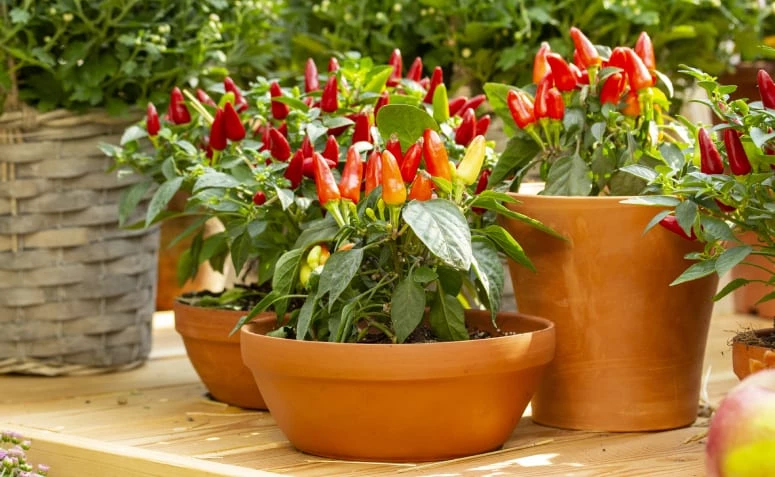Table of contents

If you are the kind of person who loves chili peppers and doesn't miss the opportunity to taste them in several meals, then you need to have your own plantation. To help you with this, we have separated tips and videos on how to plant chili peppers that will make your life easier. This way, you will have a beautiful and succulent chili plantation at home.
See_also: Plant Pots: 60 Charming Designs and Do-It-Yourself Ideas8 tips on how to grow peppers
In Brazil, it is very common to find chili peppers of many different species, such as malagueta, dedo-de-moça, cumari, de cheiro, biquinho and the famous chili pepper.
- Climate: it's important to know that chilis, in general, like warm climates and love sunshine. So, don't plant your chilis in winter, for example, to maintain the quality and production of your plantation.
- Soil: should be well drained, light, and fertile. It is essential to avoid dense soil.
- Pit: The size of the pit will depend on the size of the seedling you have in hand, however, the standard is usually 20 x 20 X 20 centimeters.
- Planting in pots: if you can't make a pit to plant your pepper directly on the ground, it is possible to plant it in a pot. In this case, the tip is to buy seedlings from specialized growers and avoid very small pots that can injure the plant's roots, you can change them as needed.
- Watering: The chili plants must be watered regularly, but it is essential to avoid soaking the soil. Remember that the chili plants must stay in the sun, so the water evaporates quickly. The famous trick of putting your finger in the soil to check the humidity of the soil never fails.
- Harvest: in favorable conditions, such as a well drained soil and warm environment, chilis can produce a lot. When harvesting, it's important to pick the chilis lightly, so that the stalk isn't damaged and the other chilis that are not yet to be harvested are not damaged. It's worth mentioning that the harvest usually takes around 50 days after flowering, but this can vary according to the species planted.
- Pruning: Pruning should only be done after the production of fruits, i.e., the ideal is to do it when the harvest has already occurred, also avoiding waste.
- How to make seedlings: The most common way to make them is through the seeds of the pepper, the most used propagation even by farmers. For extraction, the ideal is to cut the fruit in half and remove the seeds with the help of a spoon or knife, then it is important to remove the mucilage that surrounds the seeds, rubbing them with sand, for example, wash them with running water afterwards.
With all these tips on how to plant peppers and the necessary cares, it's easy to have them at home, isn't it? Now, all you have to do is choose which species you want to plant and have fresh peppers on your table every day. Below, check out some videos that will help you even more with your planting.
How to plant and make seedlings of various types of peppers
In the videos below, you will learn more precious tips on how to plant a variety of chili species and see how to do it in practice.
How to plant black pepper seedlings
In this video you will learn how to plant and grow your own chili pepper plant with a qualified professional.
See_also: Get personality outdoors with wooden decksHow to grow biquinho pepper
In this video, you will learn how to plant biquinho pepper from seeds and how to subsequently transport the pepper seedling. You will also get precious tips on the benefits of eating this pepper and how to combat pests that can strike it.
How to grow chili peppers in pots
If you have little space in your house and need to plant your chili plants in a pot, this video will help you.
How to grow ornamental pepper
Nô Figueiredo teaches how to grow the ornamental pepper at home, from a small pot seedling. The first tip is to expand the soil and the nutrients in it, transplanting the pepper to a bigger pot with richer soil. Besides, she also mentions the ideal watering, fertilization and that this pepper species has a short life span, even if it gets a lot of sun.
Learn how to plant the cambuci pepper
In this video you will learn step by step how to grow the cambuci pepper, also known in many regions as bishop's hat or priest's hat, due to its shape. In addition, there are tips for soil care and harvesting.
Planting of Finger Pepper
The "dedo-de-moça" pepper is another darling on Brazilian tables. By watching this video, you will learn how to grow this pepper species from purchased seeds. Great tips on pot size, soil quality and fertilization, as well as the daily amount of sunlight are mentioned.
How to grow peppercorns
If you are a fan of chili peppers, you can't miss the tips in this video that will show you that it is very simple to have chili peppers at home, without having to buy them at the market or at the fair.
Now, you have no excuse not to have your own pepper garden at home. With our tips and videos, you can choose your favorite pepper or plant all the peppers you like. And why not? Now, if you want to expand your garden even more, check out these tips on how to plant lettuce.


